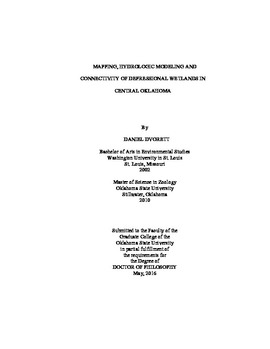| dc.contributor.advisor | Davis, Craig A. | |
| dc.contributor.author | Dvorett, Daniel Adam | |
| dc.date.accessioned | 2017-02-22T22:09:13Z | |
| dc.date.available | 2017-02-22T22:09:13Z | |
| dc.date.issued | 2016-05 | |
| dc.identifier.uri | https://hdl.handle.net/11244/48803 | |
| dc.description.abstract | The objectives of this study were to (1) develop a method to improve map quality for temporarily inundated depressional wetlands in central Oklahoma, (2) create a predictive hydrologic model for those wetlands, and (3) assess the spatiotemporal variability in landscape connectivity on invertebrate communities. | |
| dc.description.abstract | (1) Accurate wetland maps are an important resource for wetland management with applications including prioritizing restoration and tracking habitat loss. Traditional wetland maps utilize single-date imagery often underestimating ephemeral wetlands. High-recurrence satellite imagery was classified to identify patterns of inundation in regional wetlands over an 18 year period with high accuracy. Updated maps identified over 700 more wetlands than maps previously available for the area. Because new maps were created using long-term inundation information, they also included more accurate water regime attributes. | |
| dc.description.abstract | (2) Classified satellite images were also used to develop regional wetland hydrologic models. Inundation in approximately 500 wetlands was modeled over 18 years using climate data, land-use and wetland size as independent variables. The quantity, intensity and timing of rainfall as well as long-term drought indices were all important in predicting wetland inundation. Furthermore, small wetlands in grassland watersheds were less likely to be inundated than large wetlands surrounded by agriculture. Under future climate scenarios, regional wetlands are potentially at risk of decreased frequency of inundation, with small grassland wetlands most vulnerable. | |
| dc.description.abstract | (3) Landscape connectivity of inundated wetlands also impacts biotic communities. This study provides evidence for temporally variable effects of connectivity and vegetation complexity on wetland invertebrate richness and metacommunity organization. Late in the growing season vegetation complexity had a greater effect on richness and sites with similar vegetation increased in community similarity. Permanent wetlands appear to act as refuges during periods of drought and supply colonists to temporary wetlands early in the growing season. Early in the season dispersal increases wetland richness and makes proximate sites more compositionally similar. Late in the season, the spatial scale at which wetlands are connected appears to depend on the number of inundated wetlands regionally. Understanding the temporal fluctuations in local and regional effects is likely to elucidate the complex patterns of wetland invertebrate community organization. | |
| dc.format | application/pdf | |
| dc.language | en_US | |
| dc.rights | Copyright is held by the author who has granted the Oklahoma State University Library the non-exclusive right to share this material in its institutional repository. Contact Digital Library Services at lib-dls@okstate.edu or 405-744-9161 for the permission policy on the use, reproduction or distribution of this material. | |
| dc.title | Mapping, hydrologic modeling and connectivity of depressional wetlands in central Oklahoma | |
| dc.contributor.committeeMember | Bidwell, Joseph R. | |
| dc.contributor.committeeMember | Zou, Chris Bocai | |
| dc.contributor.committeeMember | Papes, Monica | |
| osu.filename | Dvorett_okstate_0664D_14598.pdf | |
| osu.accesstype | Open Access | |
| dc.type.genre | Dissertation | |
| dc.type.material | Text | |
| thesis.degree.discipline | Natural Resource Ecology and Management | |
| thesis.degree.grantor | Oklahoma State University | |
